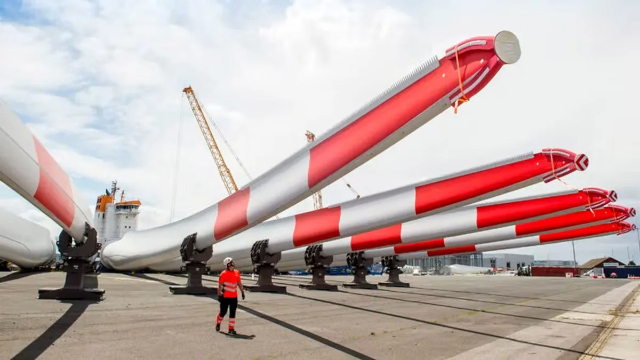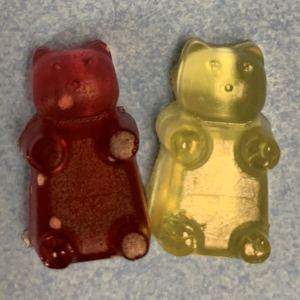We’ve covered the phenomenon of ‘upcycling’ in this space before. That’s the reprocessing of food waste products into new food products. Now a slightly different tack is being taken: reprocessing non-food waste into new foods…

Siemens Gamesa’s RecyclableBlades: Turnine blades can more than
200 feet long and weigh many tonnes. That’s a lot Gummy bears!
A new article in Interesting Engineering proposes a new technique for the perpetual circular recycling of the structural material in wind turbine blades.
“This innovation can have far-reaching consequences. Over the years, wind power has become an increasingly popular form of renewable energy. But, when it’s time to replace the huge turbine blades that convert wind into electricity, disposal is an enormous problem.
“In 2020, Bloomberg reported that about 8,000 wind turbines will be removed in each of the next four years in the U.S. alone. Europe has about 3,800 coming down every year through at least 2022. […] Most of these were built more than a decade ago when installations [numbered’ less than a fifth of what they are now. [And] [t]he problem is only going to get worse.”
How it works
Fibrerglas is a resin-based material with great strength and durability. But it is basically the same composition as the base material many other products are made from.
The IE article explains, “Scientists at the Michigan State University have created a distinct turbine material that can be revived and recycled into new turbine blades or a variety of other products, including countertops, car tail lights, diapers, and even gummy bears.”
And I’ll bet you thought I couldn’t bend this topic back around to include a food-related angle!
Now, a new composite resin has been developed that can be sent round and round a recycling ‘wheel’. That means that, after a turbine blade reaches the end of its useful life, it can ‘melted down’ to its base resin and turned into new products. The great part is, the base material never degrades to the point where it can no longer be recycled. You can’t do that with paper pulp and many other so-called recyclables. Beverage can aluminum and glass being notable exceptions.
The chemistry
Or is it magic? Just kidding. But it does seem too good to be true, at least at first glance.
The key is the new resin, says Dr. John Dorgan, who recently reported the results of his new Michigan State University study to the latest meeting of the American Chemical Society: “The beauty of our resin system is that at the end of its use cycle, we can dissolve it, and that releases it from whatever matrix it’s in so that it can be used over and over again in an infinite loop. […] That’s the goal of the circular economy.”
Where I got skeptical
… Is when Drogan begins talking about reprocessing the resin into feed stocks for making new food products.
Interestingly, the alkaline digestion [re-melting] also produced potassium lactate, which can be purified and made into candy and sports drinks. “We recovered food-grade potassium lactate and used it to make gummy bear candies (see photo, top of page), which I ate,” Dorgan said.
Fine for him. It’s his choice. Bit I’d be very wary of eating any food made from a base material originally used in turbine blades or any other outdoor application, where something known to be porous – like fibreglas – is exposed to al the myriad pollutants and chemicals present in the air and rainwater these days.
Sure, Drogan insists, he resin variant they used to make the bears, ‘food-grade potassium lactate’, was ‘purified’. but I’d need to know a lot more about the purification process and the levels of any contaminants left in the material, even in trace amounts. Just saying.
Not the only such proposal on the table
In fairness, Drogan’s resin cycle is not the only process on the table, vying for some kind certification by the folks who oversee the circular economy. Whoever the they be. The are many other concepts that fall just short of perpetual recycling, from making beer from recycled sewage to transforming seaweed into plant-based bacon.
The other side of that coin involves making building materials from straw or grain husks, for example.
My question to you: Would you eat the gummies?
Muse on that…
~ Maggie J.

